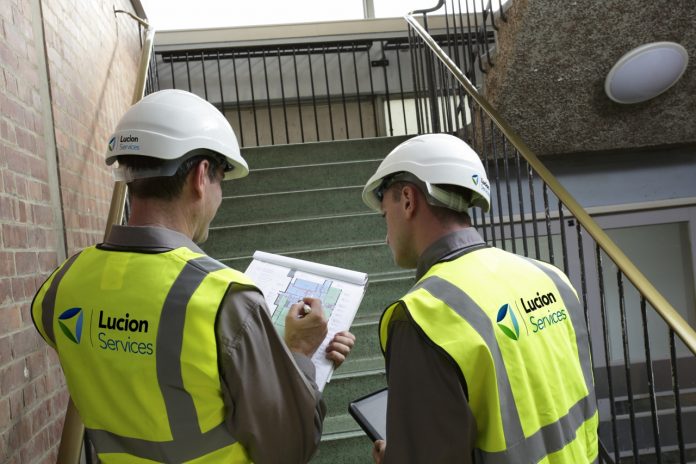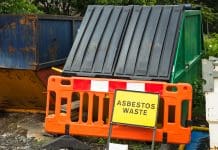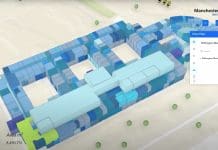Charles Pickles of Lucion says the UK needs to bring its asbestos monitoring regulations in line with other countries who have more robust controls despite having less of a problem
A comparison of international trade statistics shows that historically the UK has imported relatively more asbestos per capita than most other countries. In addition, much more of this tonnage was of the more dangerous fibre types, amosite (brown asbestos) and crocidolite (blue asbestos), rather than chrysotile (white asbestos), in comparison to other countries.
During the 1950s to 1980s, much of this asbestos was incorporated into building materials (Asbestos Containing Materials – ACMs) and installed in public buildings, where it remains in an increasingly aged state and often in a deteriorating condition.
The UK asbestos regulations broadly aim to locate asbestos within buildings and prevent acute disturbance to these materials by maintenance workers who would otherwise be unaware of their presence and the hazards presented. The regulations presume asbestos left in-situ and which is not subject to building/maintenance work is of little risk.
Earlier asbestos legislation has drastically reduced asbestos exposure and demonstrated that legislation is the most effective tool we have to control asbestos risk.
Nevertheless, there is now serious and growing concern over current exposure levels from asbestos that remains in-situ because the materials themselves have either been damaged and/or are degrading, which increases the likelihood of fibres being released into the air and increasing the likelihood of exposure.
Concern about low-level chronic exposure to asbestos is now justified due to the following reasons:
- Much of the asbestos installed remains in-situ, with no effective regime for measuring any resulting current exposure.
- Exposure is cumulative and there is little understanding of the level of the actual chronic exposure from asbestos left in-situ.
- Workers (eg teachers, caretakers, nurses) not associated with acute exposure are dying from previous asbestos exposure and shall die in the future as a result of current and future exposure.
- Generally, people are now living longer, giving asbestos disease longer to manifest itself.
- Children in schools risk becoming exposed to asbestos at a younger age, again increasing the years available for asbestos disease to develop.

All health and safety law in the UK is governed by the principles that emergent best practices and techniques are adopted as they become available. In 2002, the Control of Asbestos at Work Regulations (CAWR) were established, introducing the “duty to manage” asbestos, requiring property managers and owners to locate and prevent exposure to asbestos.
CAWR was amended in 2012 to bring the regulations into line with the EU Directive on exposure to asbestos (Directive 2009/148/EC).
However, it is asbestos fibres, not asbestos materials, that are dangerous. Yet currently for in-use buildings, it is the materials rather than the fibre concentrations that are routinely assessed. This practice should be modified to enable improved management of the both the fibre levels and the materials from which fibres originate.
To do this, there is a need to amend and enhance the Duty to Manage terms within the Control of Asbestos Regulations, (2012) to:
- Set an occupational exposure limit for buildings known to contain high risk materials (R1 and R2), of <0.0005 f/ml, to ensure that respirable asbestos fibre levels in occupied buildings, known to contain high risk asbestos, are below the level known to present an elevated risk of asbestos disease.
- Prove ongoing compliance at the time of the reinspection visit, thus fully ratifying and verifying compliance with the Duty to Manage, by reporting that asbestos exposure is either negligible or that management action is planned/is being enacted.
Our current practice for measuring asbestos exposure (Phase Contrast Microscopy – PCM) is insufficiently sensitive to observe the vast majority of asbestos fibres in a given sample of air.
Other nations with much less of an asbestos problem have adopted sensitive air monitoring techniques, such as Scanning Electron Microscopy (SEM), and thus are able to monitor much lower exposures. As a result, in the UK, we simply do not know what exposures people in our public buildings and workplaces are being exposed to.
Given that asbestos is very widespread and is the number one occupational cause of death, it is argued that the UK ought to continue to adopt best practice as it evolves, particularly for testing air within buildings containing high risk asbestos, to be assured of their ongoing safety.
Lucion’s report, Why the UK Needs Tighter Asbestos Controls, can be downloaded here. [Link – http://www.lucionservices.com/asbestosinschools/]
Charles Pickles
Chief Technical Officer
Lucion Services
Tel: +44 (0)191 4618999
www.twitter.com/lucionservices
www.linkedin.com/company/lucion-services/














